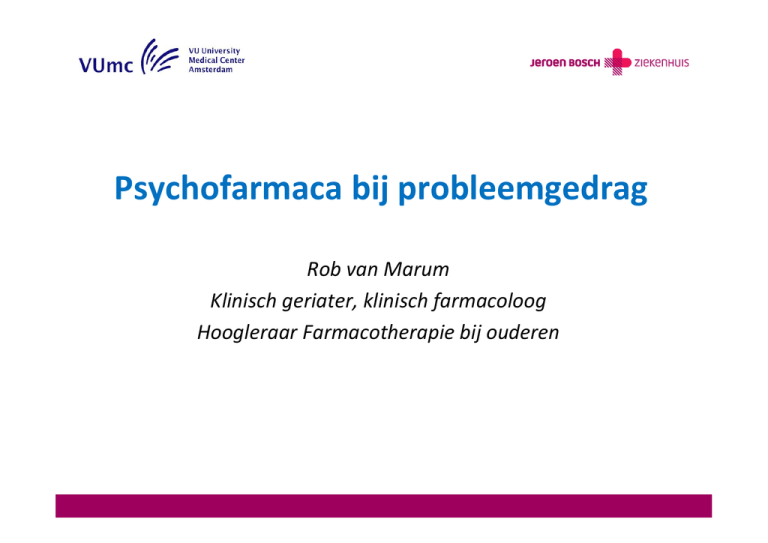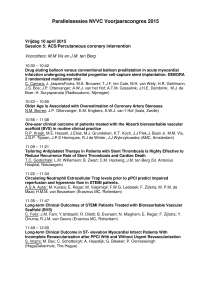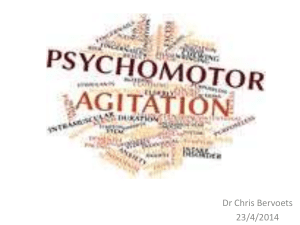Psychofarmaca bij probleemgedrag
advertisement

Psychofarmaca bij probleemgedrag Rob van Marum Klinisch geriater, klinisch farmacoloog Hoogleraar Farmacotherapie bij ouderen Neuropsychiatrische symptomen Cognitieve symptomen Functionele symptomen Neuropsychiatrische symptomen probleemgedrag - Roepen - Agressie - Dwalen - Ontremming - Apathie psychiatrische stoornissen - Hallucinaties - Wanen - Depressie - Angststoornissen aantal gebruikers van antipsychotica per 1000 inwoners in de betreffende leeftijdsgroep 17 september 2010, Pharmaceutisch Weekblad, Jaargang 145 Nr 37 Aantal voorschriften antipsychotica Antipsychoticum 21-64 jaar ≥ 65 jaar Haloperidol 6% 26% Risperidon 16% 21% Olanzapine 20% 17% Quetiapine 23% 13% Pipamperon 6% 7% Clozapine 8% 4% 1.041.000 voorschriften 380.000 voorschriften 17 september 2010, Pharmaceutisch Weekblad, Jaargang 145 Nr 37 Het eerste AP: chloorpromazine (1950) When Thorazine is administred to the agitated senile, there is a marked decrease in his nerve racking outbursts of hostility, irritability, abusiveness and ‘day-and-night’ pacing. .. more regular eating and sleeping habits and improves in his personal hygiene. Dopamine pathways a: nigrostriataal b: mesolimbisch c: mesocorticaal d: tuberoinfundibulair e: 5e Dopamine-blokkade • Mesolimbisch systeem - Reductie positieve symptomen (hallucinaties, wanen) - Versterking negatieve symptomen (minder motivatie, apathie, anhedonie, minder reward) • Nigrostriatale systeem - Extrapyramidale bewegingsstoornissen • Mesocorticale systeem naar prefrontaal (DLPFC/VMPFC) - Cognitieve en emotionele achteruitgang Klassiek AP • D2 antagonisme - Vermindering psychose - EPS: parkinsonisme, tardieve dyskinesie - Verhoging prolactine (galactorrhoe, amenorroe, impotentie, osteoporose) - Neurolepsie • >60-70% bezetting D2 receptor. Bij >80% bijwerkingen Conventioneel AP Anticholinergicum bij EPS? Wat is atypisch? minder D2 blokkade! Hoe doe je dat? • 5HT2a-antagonisme - Clozapine, risperidon, olanzapine, ziprasidone (quetiapine? ) • 5HT1a-agonisme (partieel) - Ziprasidone, quetiapine, clozapine, aripiprazole • D2 antagonisme met snelle dissociatie (hit and run) - Clozapine, quetiapine • D2 partieel agonisme - Aripiprazole, sulpiride Atypisch AP: de rol van serotonine 5HT2a receptor • M.n. nigrostriatale en 5HT1a receptor tuburo infundibulaire systeem Atypisch AP Receptor en bijwerkingen: overig • Anticholinerg - Cognitie ⇓ - Urineretentie - Obstipatie - Wazige visus - Droge mond - Sufheid, slaperigheid • Anti-5HT2 - Minder agitatie, agressie - Verlengen diepe slaap • α-Adrenerg - Orthostase - Vallen - hypnosedatie • Histaminerg - Sedatie - gewichtstoename AP generiek D2 5HT2a ACh Alfa1 Hist Haloperidol ++++ + nvt + - risperidon +++ +++++ nvt ++ + olanzapine ++ +++ ++ + +++ quetiapine + ++ + + +++ clozapine + ++ ++ ++ ++++ aripiprazole +++ +++ ? ++ ++ pipamperon ++ +++ nvt ++ - Sedatie? • Demping: remming psychomotoriek, angst. agitatie • Onverschillig makend: minder agressie, vijandigheid • Hypnosedatie: suf en slaperig Kinetiek T1/2 (uren) Tmax (uren) Metabolisme Haloperidol 20 2-6 3A4, 2D6 Pipamperon 11-35 2 - Risperidon 3 (24) 1-2 2D6 Clozapine 12 (6-26) 1-3 1A2, 3A4, 2D6 Olanzapine 30 (50) 5-8 1A2, 2D6 Quetiapine 9-11 1-2 3A4 Levomepromazine 15-78 1-4 Eliminatie Concentratie x 100% 50% x 25% x 1 2 12.5% x 3 6.25% x 4 3.125% x 5 Halfwaardetijd Zwart: dosering T1/2 Concentratie Rood: ½ dosering 2x/T1/2 Blauw: continue infusie 2 1 T 1/2 Tijd Zwart: dosering T1/2 Concentratie Rood: 2x dosering bolus + dosering T 1/2 Blauw: continue infusie 2 1 T 1/2 Tijd Antidepressiva Serotonine reuptake inhibition NE reuptake inhibition Histamine blokkade Alfa-1 blokkade Muscarine blokkade SSRI’s en remming CYP450 CYP isoform Citalopram Fluoxetine CYP1A2 NA NA CYP2C9 CYP2D6 -/+ CYP3A4 NA + +++ + CYP2C19 Fluvoxamine +++ +/++ ++/+++ + + Paroxetine Sertraline NA +++ - -/+ -/+ + - NA: niet beschikbaar, - geen effect, + >50% verandering ++ 50-150% verandering, +++ >150% verandering Benzodiazepines en vallen • Alle benzo’s geven een verhoogd valrisico, • Vallen meestal ‘s nachts • Exponentieel risico 2002 (revisie 2008) Effectiveness of Atypical Antipsychotic Drugs in Patients with Alzheimer's Disease N Engl J Med. 2006 Oct 12;355(15):1604-6. Memantine en agitatie Psychofarmaca zijn niet onschuldig!! FDA 2008 • FDA ALERT [6/16/2008]: FDA is notifying healthcare professionals that both conventional and atypical antipsychotics are associated with an increased risk of mortality in elderly patients treated for dementia-related psychosis. Considerations for Healthcare Professionals • Elderly patients with dementia-related psychosis treated with conventional or atypical antipsychotic drugs are at an increased risk of death. • Antipsychotic drugs are not approved for the treatment of dementia-related psychosis. Furthermore, there is no approved drug for the treatment of dementiarelated psychosis. Healthcare professionals should consider other management options. • Physicians who prescribe antipsychotics to elderly patients with dementia-related psychosis should discuss this risk of increased mortality with their patients, patients’ families, and caregivers. • Fifteen trials (9 unpublished), generally 10 to 12 weeks in duration, including 16 contrasts of atypical antipsychotic drugs with placebo • Death occurred more often among patients randomized to drugs (118 [3.5%] vs 40 [2.3%]. The OR by meta-analysis was 1.54; 95% confidence interval [CI], 1.06-2.23; P=.02; • Considering that many of these trials demonstrated that these medications are only modestly effective with numbers needing to treat ranging from 4 to 12 in specific metaanalyses, the likelihood for helping vs harming may be rather modest as well, such that for every 9 to 25 persons helped in these trials there possibly will be 1 death. Behandelen van 1000 patienten met BPSD met een ap gedurende 3 maanden leidt tot: • Klinische verbetering bij 91-200 pten • Overlijden 10 patienten - Bij langer behandelen toename sterfte • Beroerte 18 patienten http://www.dh.gov.uk/prod_consum_ dh/groups/dh_digitalassets/document s/digitalasset/dh_108302.pdf Antipsychotica en CVA Kleijer BC, van Marum RJ, Egberts AC, Jansen PA, Knol W, Heerdink ER. All cause mortality TCA SSRI other Myocard infarct TCA SSRI other Beroerte/TIA TCA SSRI other Vallen TCA SSRI other Fractuur TCA SSRI other Adj. OR (95% CI) 1.16 (1.10 – 1.22) 1.54 (1.48 – 1.59) 1.66 (1.56 – 1.77) 1.09 (0.96 – 1.23) 1.15 (1.04 – 1.27) 5.16 (3.90 – 6.83) 1.02 ( 0.93 – 1.11) 1.17 (1.10 – 1.26) 1.37 (1.22 – 1.55) 1.30 ( 1.23 – 1.38) 1.66 (1.58 – 1.73) 1.39 (1.28 – 1.52) 1.26 (1.16 – 1.37) 1.58 (1.48 – 1.68) 1.64 (1.46 – 1.84) Hoge tr. Digest. bloeding TCA SSRI other Insulten TCA SSRI other Bijwerkingen TCA SSRI other Hyponatriemie TCA SSRI other Adj. OR (95% CI) 1.29 (1.10 – 1.51) 1.22 (1.07 – 1.40) 1.37 (1.08 – 1.74) 1.02 (0.76 – 1.38) 1.83 (1.49 – 2.26) 2.24 (1.60 – 3.15) 1.06 ( 0.86 – 1.29) 1.16 (0.98 – 1.37) 0.95(0.68– 1.34) 1.05 ( 0.87 – 1.27) 1.52 (1.33 – 1.75) 1.28 (0.98 – 1.672)
![Antipsychotica en moeilijk behandelbaar[1].ppt](http://s2.studylib.net/store/data/005607009_1-851f8cbf1bf28dd8583e7937ffcfd53f-300x300.png)

